Analysis of HRM: Strategic Approach, Flexibility, and Legislation
VerifiedAdded on 2023/04/17
|22
|4474
|429
Report
AI Summary
This report delves into topical issues in Human Resource Management (HRM), focusing on Guest's model and its application to MacDonald's, comparing Storey's definitions of HRM, personnel, and IR practices across organizations. It assesses the implications of a strategic HRM approach for MacDonald's line managers and employees, explores flexibility models, and discusses the impact of labor market changes on flexible working practices. The report also examines workplace discrimination, the practical implications of equal opportunities legislation for McDonalds, and compares approaches to managing equal opportunities and diversity. Furthermore, it identifies and compares performance management in a selected organization, assesses approaches to managing employee welfare, discusses the implications of health and safety legislation on human resources practices, and evaluates the impact of another topical issue on human resources practices. The paper highlights the evolving role of employees in driving organizational growth and the importance of HRM in creating strategy and ensuring the right personnel are in place.
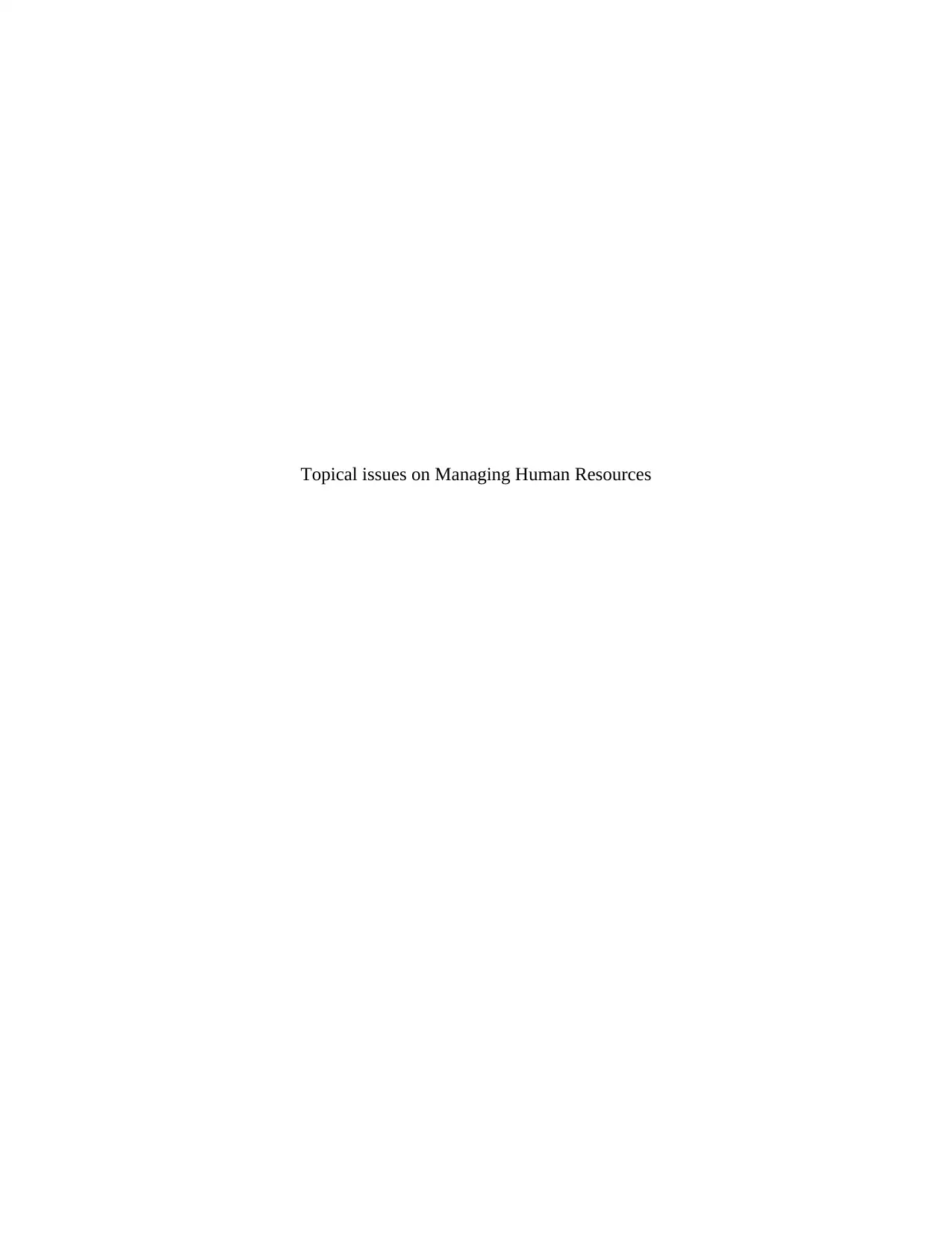
Topical issues on Managing Human Resources
Paraphrase This Document
Need a fresh take? Get an instant paraphrase of this document with our AI Paraphraser
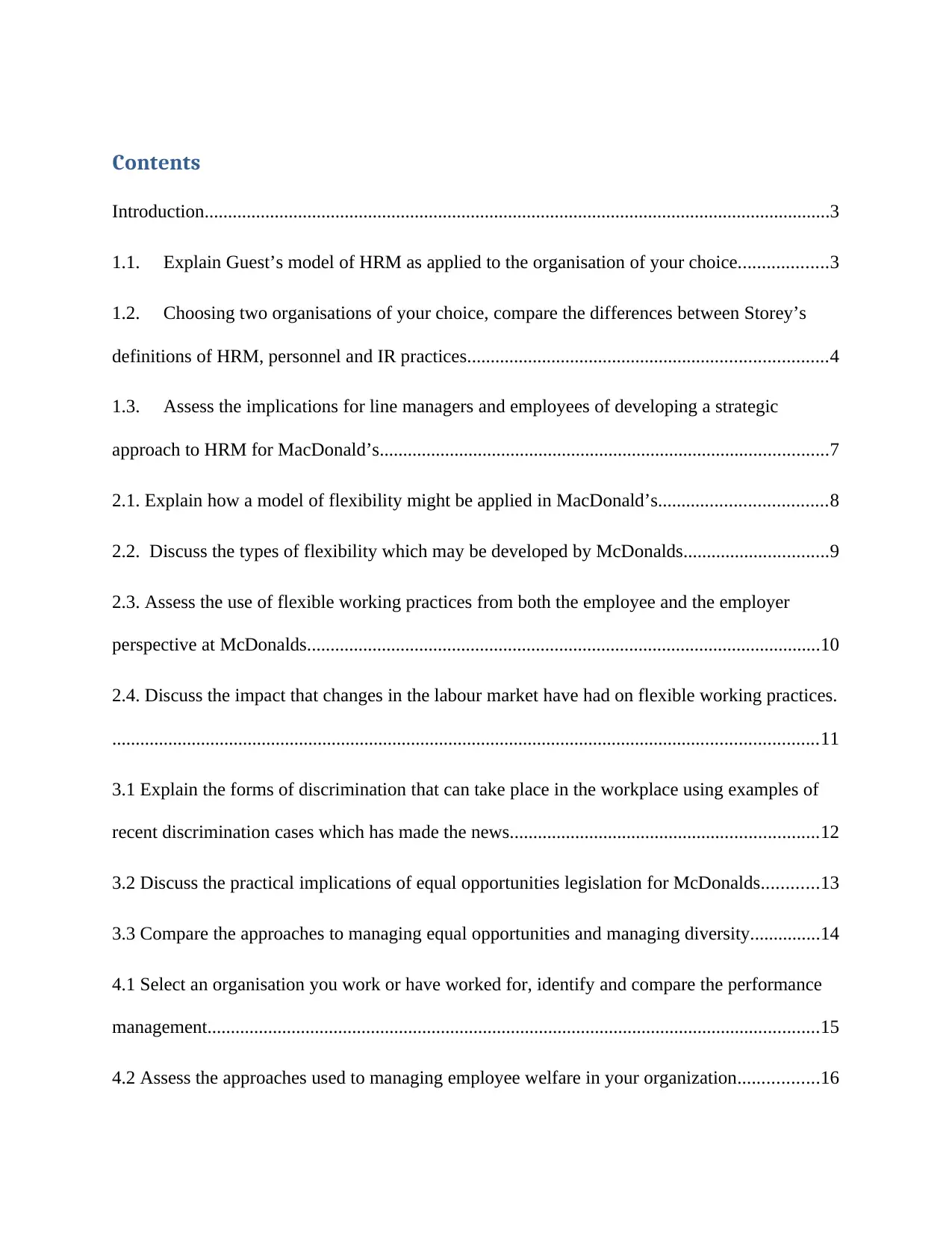
Contents
Introduction......................................................................................................................................3
1.1. Explain Guest’s model of HRM as applied to the organisation of your choice...................3
1.2. Choosing two organisations of your choice, compare the differences between Storey’s
definitions of HRM, personnel and IR practices.............................................................................4
1.3. Assess the implications for line managers and employees of developing a strategic
approach to HRM for MacDonald’s................................................................................................7
2.1. Explain how a model of flexibility might be applied in MacDonald’s....................................8
2.2. Discuss the types of flexibility which may be developed by McDonalds...............................9
2.3. Assess the use of flexible working practices from both the employee and the employer
perspective at McDonalds..............................................................................................................10
2.4. Discuss the impact that changes in the labour market have had on flexible working practices.
.......................................................................................................................................................11
3.1 Explain the forms of discrimination that can take place in the workplace using examples of
recent discrimination cases which has made the news..................................................................12
3.2 Discuss the practical implications of equal opportunities legislation for McDonalds............13
3.3 Compare the approaches to managing equal opportunities and managing diversity...............14
4.1 Select an organisation you work or have worked for, identify and compare the performance
management...................................................................................................................................15
4.2 Assess the approaches used to managing employee welfare in your organization.................16
Introduction......................................................................................................................................3
1.1. Explain Guest’s model of HRM as applied to the organisation of your choice...................3
1.2. Choosing two organisations of your choice, compare the differences between Storey’s
definitions of HRM, personnel and IR practices.............................................................................4
1.3. Assess the implications for line managers and employees of developing a strategic
approach to HRM for MacDonald’s................................................................................................7
2.1. Explain how a model of flexibility might be applied in MacDonald’s....................................8
2.2. Discuss the types of flexibility which may be developed by McDonalds...............................9
2.3. Assess the use of flexible working practices from both the employee and the employer
perspective at McDonalds..............................................................................................................10
2.4. Discuss the impact that changes in the labour market have had on flexible working practices.
.......................................................................................................................................................11
3.1 Explain the forms of discrimination that can take place in the workplace using examples of
recent discrimination cases which has made the news..................................................................12
3.2 Discuss the practical implications of equal opportunities legislation for McDonalds............13
3.3 Compare the approaches to managing equal opportunities and managing diversity...............14
4.1 Select an organisation you work or have worked for, identify and compare the performance
management...................................................................................................................................15
4.2 Assess the approaches used to managing employee welfare in your organization.................16
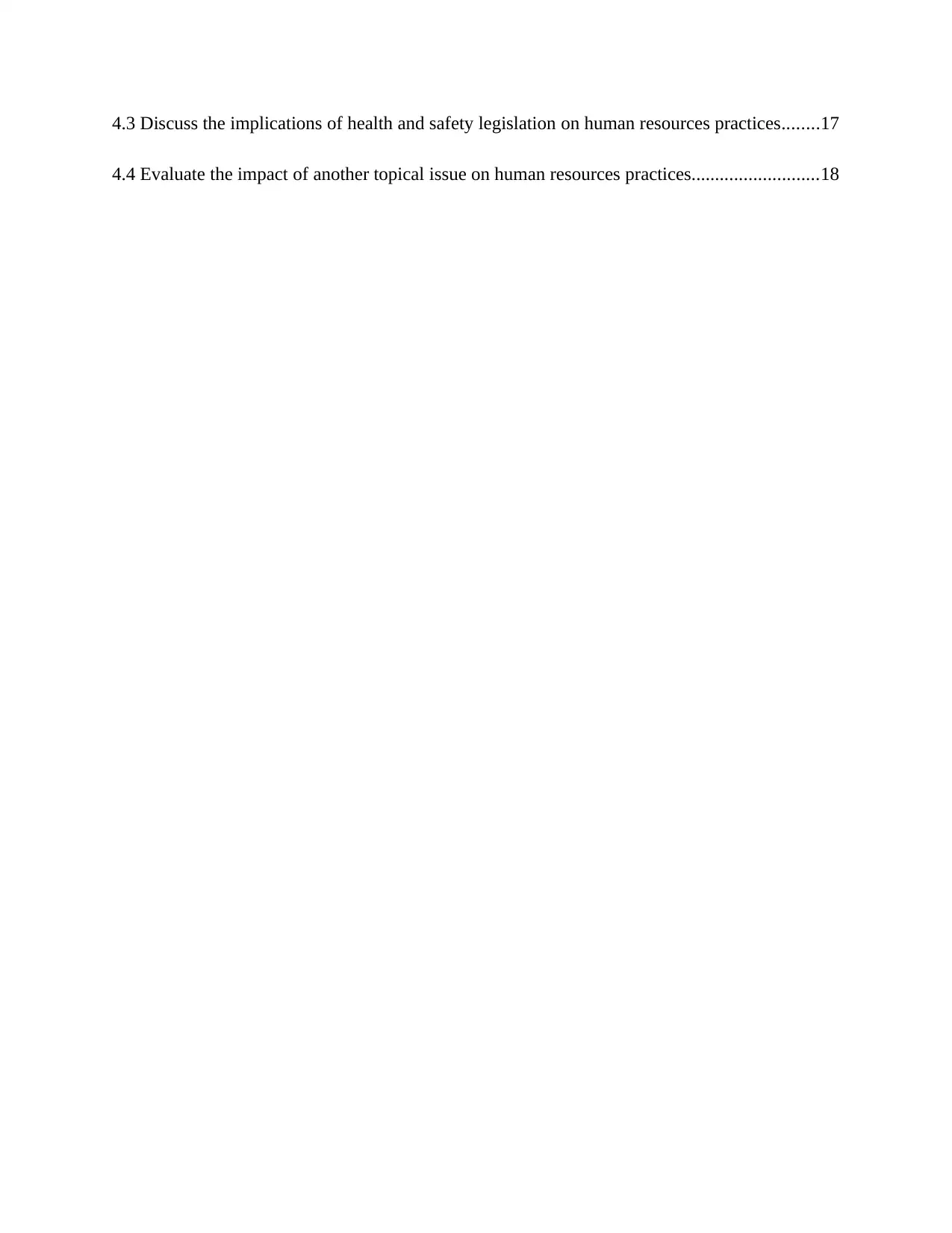
4.3 Discuss the implications of health and safety legislation on human resources practices........17
4.4 Evaluate the impact of another topical issue on human resources practices...........................18
4.4 Evaluate the impact of another topical issue on human resources practices...........................18
⊘ This is a preview!⊘
Do you want full access?
Subscribe today to unlock all pages.

Trusted by 1+ million students worldwide
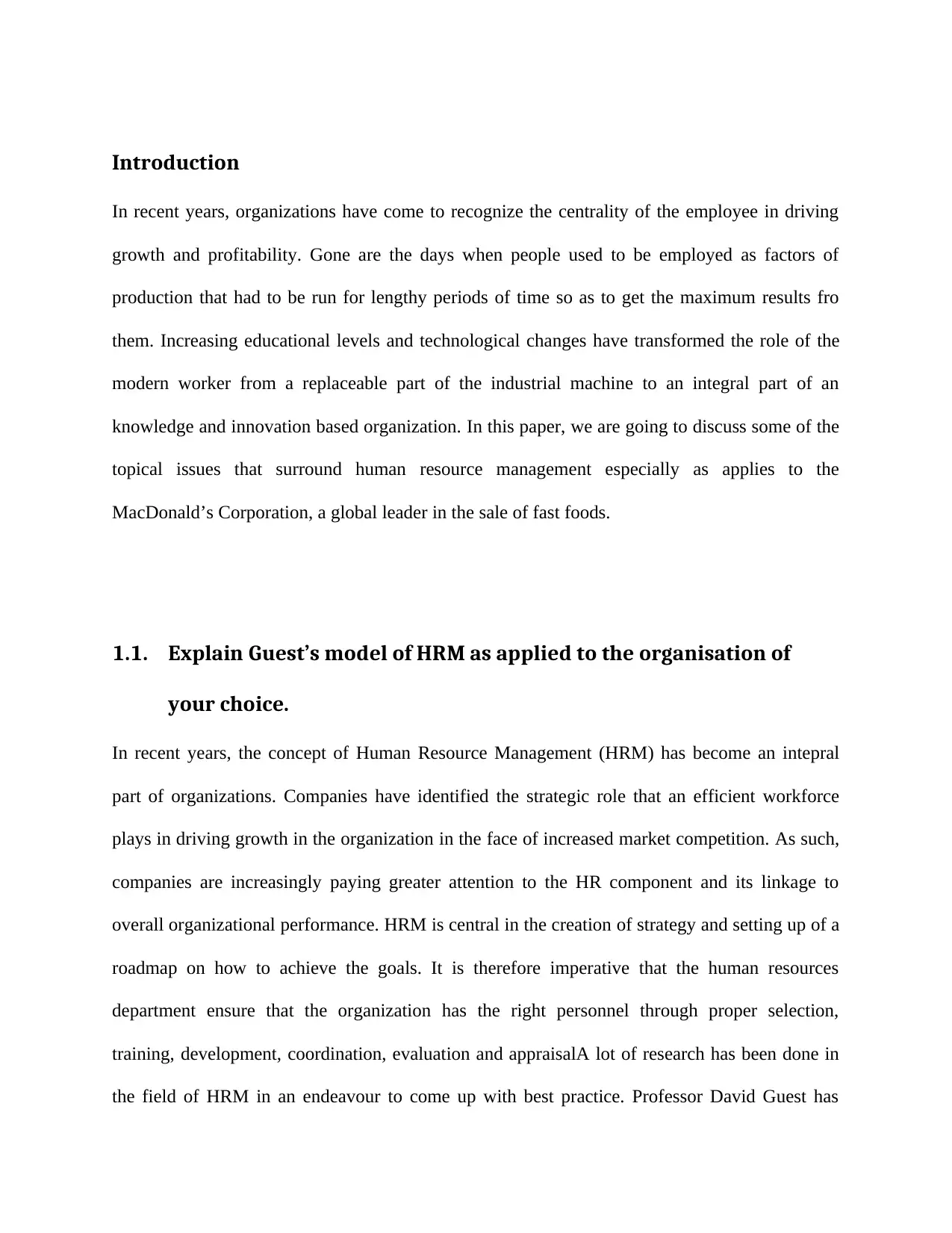
Introduction
In recent years, organizations have come to recognize the centrality of the employee in driving
growth and profitability. Gone are the days when people used to be employed as factors of
production that had to be run for lengthy periods of time so as to get the maximum results fro
them. Increasing educational levels and technological changes have transformed the role of the
modern worker from a replaceable part of the industrial machine to an integral part of an
knowledge and innovation based organization. In this paper, we are going to discuss some of the
topical issues that surround human resource management especially as applies to the
MacDonald’s Corporation, a global leader in the sale of fast foods.
1.1. Explain Guest’s model of HRM as applied to the organisation of
your choice.
In recent years, the concept of Human Resource Management (HRM) has become an intepral
part of organizations. Companies have identified the strategic role that an efficient workforce
plays in driving growth in the organization in the face of increased market competition. As such,
companies are increasingly paying greater attention to the HR component and its linkage to
overall organizational performance. HRM is central in the creation of strategy and setting up of a
roadmap on how to achieve the goals. It is therefore imperative that the human resources
department ensure that the organization has the right personnel through proper selection,
training, development, coordination, evaluation and appraisalA lot of research has been done in
the field of HRM in an endeavour to come up with best practice. Professor David Guest has
In recent years, organizations have come to recognize the centrality of the employee in driving
growth and profitability. Gone are the days when people used to be employed as factors of
production that had to be run for lengthy periods of time so as to get the maximum results fro
them. Increasing educational levels and technological changes have transformed the role of the
modern worker from a replaceable part of the industrial machine to an integral part of an
knowledge and innovation based organization. In this paper, we are going to discuss some of the
topical issues that surround human resource management especially as applies to the
MacDonald’s Corporation, a global leader in the sale of fast foods.
1.1. Explain Guest’s model of HRM as applied to the organisation of
your choice.
In recent years, the concept of Human Resource Management (HRM) has become an intepral
part of organizations. Companies have identified the strategic role that an efficient workforce
plays in driving growth in the organization in the face of increased market competition. As such,
companies are increasingly paying greater attention to the HR component and its linkage to
overall organizational performance. HRM is central in the creation of strategy and setting up of a
roadmap on how to achieve the goals. It is therefore imperative that the human resources
department ensure that the organization has the right personnel through proper selection,
training, development, coordination, evaluation and appraisalA lot of research has been done in
the field of HRM in an endeavour to come up with best practice. Professor David Guest has
Paraphrase This Document
Need a fresh take? Get an instant paraphrase of this document with our AI Paraphraser
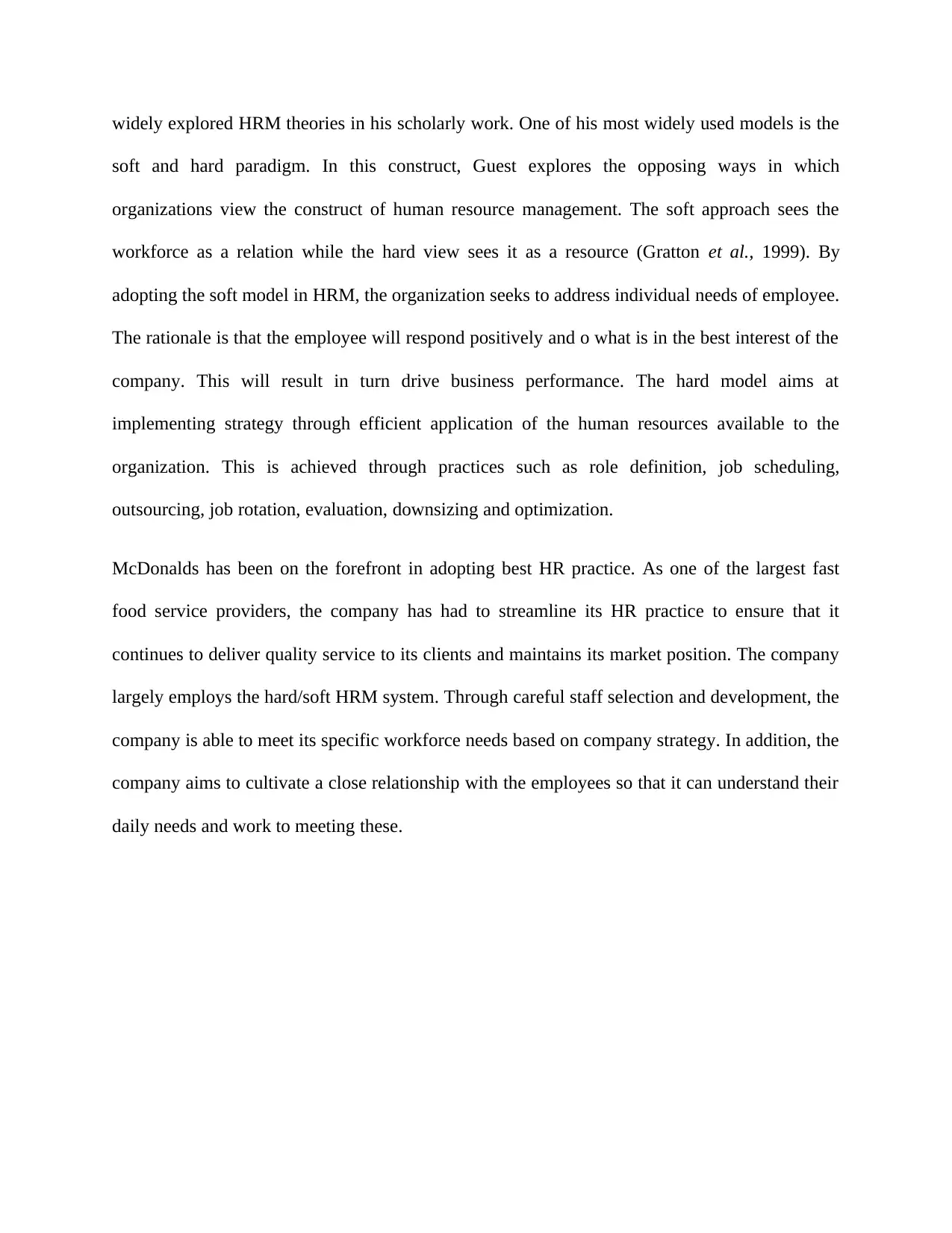
widely explored HRM theories in his scholarly work. One of his most widely used models is the
soft and hard paradigm. In this construct, Guest explores the opposing ways in which
organizations view the construct of human resource management. The soft approach sees the
workforce as a relation while the hard view sees it as a resource (Gratton et al., 1999). By
adopting the soft model in HRM, the organization seeks to address individual needs of employee.
The rationale is that the employee will respond positively and o what is in the best interest of the
company. This will result in turn drive business performance. The hard model aims at
implementing strategy through efficient application of the human resources available to the
organization. This is achieved through practices such as role definition, job scheduling,
outsourcing, job rotation, evaluation, downsizing and optimization.
McDonalds has been on the forefront in adopting best HR practice. As one of the largest fast
food service providers, the company has had to streamline its HR practice to ensure that it
continues to deliver quality service to its clients and maintains its market position. The company
largely employs the hard/soft HRM system. Through careful staff selection and development, the
company is able to meet its specific workforce needs based on company strategy. In addition, the
company aims to cultivate a close relationship with the employees so that it can understand their
daily needs and work to meeting these.
soft and hard paradigm. In this construct, Guest explores the opposing ways in which
organizations view the construct of human resource management. The soft approach sees the
workforce as a relation while the hard view sees it as a resource (Gratton et al., 1999). By
adopting the soft model in HRM, the organization seeks to address individual needs of employee.
The rationale is that the employee will respond positively and o what is in the best interest of the
company. This will result in turn drive business performance. The hard model aims at
implementing strategy through efficient application of the human resources available to the
organization. This is achieved through practices such as role definition, job scheduling,
outsourcing, job rotation, evaluation, downsizing and optimization.
McDonalds has been on the forefront in adopting best HR practice. As one of the largest fast
food service providers, the company has had to streamline its HR practice to ensure that it
continues to deliver quality service to its clients and maintains its market position. The company
largely employs the hard/soft HRM system. Through careful staff selection and development, the
company is able to meet its specific workforce needs based on company strategy. In addition, the
company aims to cultivate a close relationship with the employees so that it can understand their
daily needs and work to meeting these.
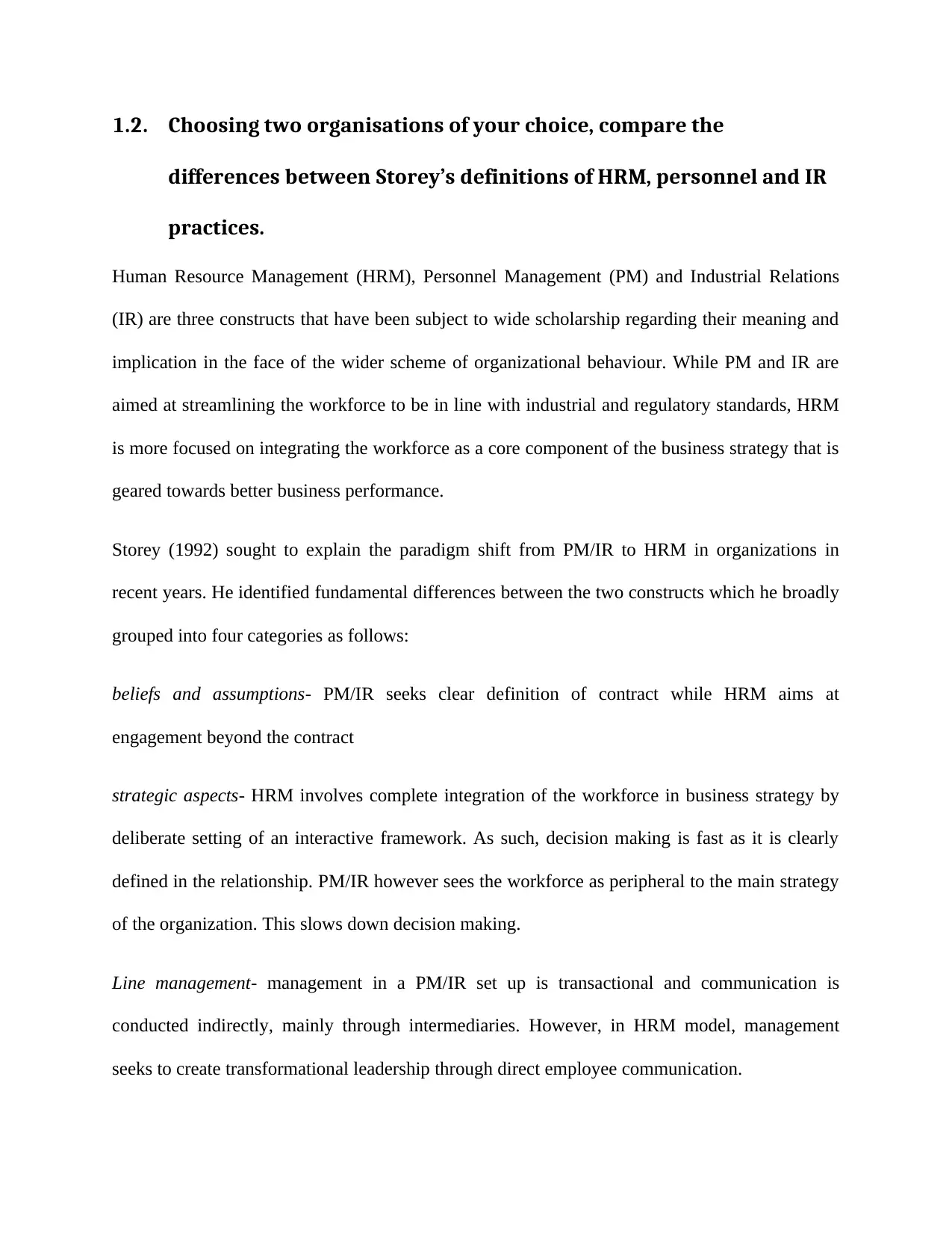
1.2. Choosing two organisations of your choice, compare the
differences between Storey’s definitions of HRM, personnel and IR
practices.
Human Resource Management (HRM), Personnel Management (PM) and Industrial Relations
(IR) are three constructs that have been subject to wide scholarship regarding their meaning and
implication in the face of the wider scheme of organizational behaviour. While PM and IR are
aimed at streamlining the workforce to be in line with industrial and regulatory standards, HRM
is more focused on integrating the workforce as a core component of the business strategy that is
geared towards better business performance.
Storey (1992) sought to explain the paradigm shift from PM/IR to HRM in organizations in
recent years. He identified fundamental differences between the two constructs which he broadly
grouped into four categories as follows:
beliefs and assumptions- PM/IR seeks clear definition of contract while HRM aims at
engagement beyond the contract
strategic aspects- HRM involves complete integration of the workforce in business strategy by
deliberate setting of an interactive framework. As such, decision making is fast as it is clearly
defined in the relationship. PM/IR however sees the workforce as peripheral to the main strategy
of the organization. This slows down decision making.
Line management- management in a PM/IR set up is transactional and communication is
conducted indirectly, mainly through intermediaries. However, in HRM model, management
seeks to create transformational leadership through direct employee communication.
differences between Storey’s definitions of HRM, personnel and IR
practices.
Human Resource Management (HRM), Personnel Management (PM) and Industrial Relations
(IR) are three constructs that have been subject to wide scholarship regarding their meaning and
implication in the face of the wider scheme of organizational behaviour. While PM and IR are
aimed at streamlining the workforce to be in line with industrial and regulatory standards, HRM
is more focused on integrating the workforce as a core component of the business strategy that is
geared towards better business performance.
Storey (1992) sought to explain the paradigm shift from PM/IR to HRM in organizations in
recent years. He identified fundamental differences between the two constructs which he broadly
grouped into four categories as follows:
beliefs and assumptions- PM/IR seeks clear definition of contract while HRM aims at
engagement beyond the contract
strategic aspects- HRM involves complete integration of the workforce in business strategy by
deliberate setting of an interactive framework. As such, decision making is fast as it is clearly
defined in the relationship. PM/IR however sees the workforce as peripheral to the main strategy
of the organization. This slows down decision making.
Line management- management in a PM/IR set up is transactional and communication is
conducted indirectly, mainly through intermediaries. However, in HRM model, management
seeks to create transformational leadership through direct employee communication.
⊘ This is a preview!⊘
Do you want full access?
Subscribe today to unlock all pages.

Trusted by 1+ million students worldwide
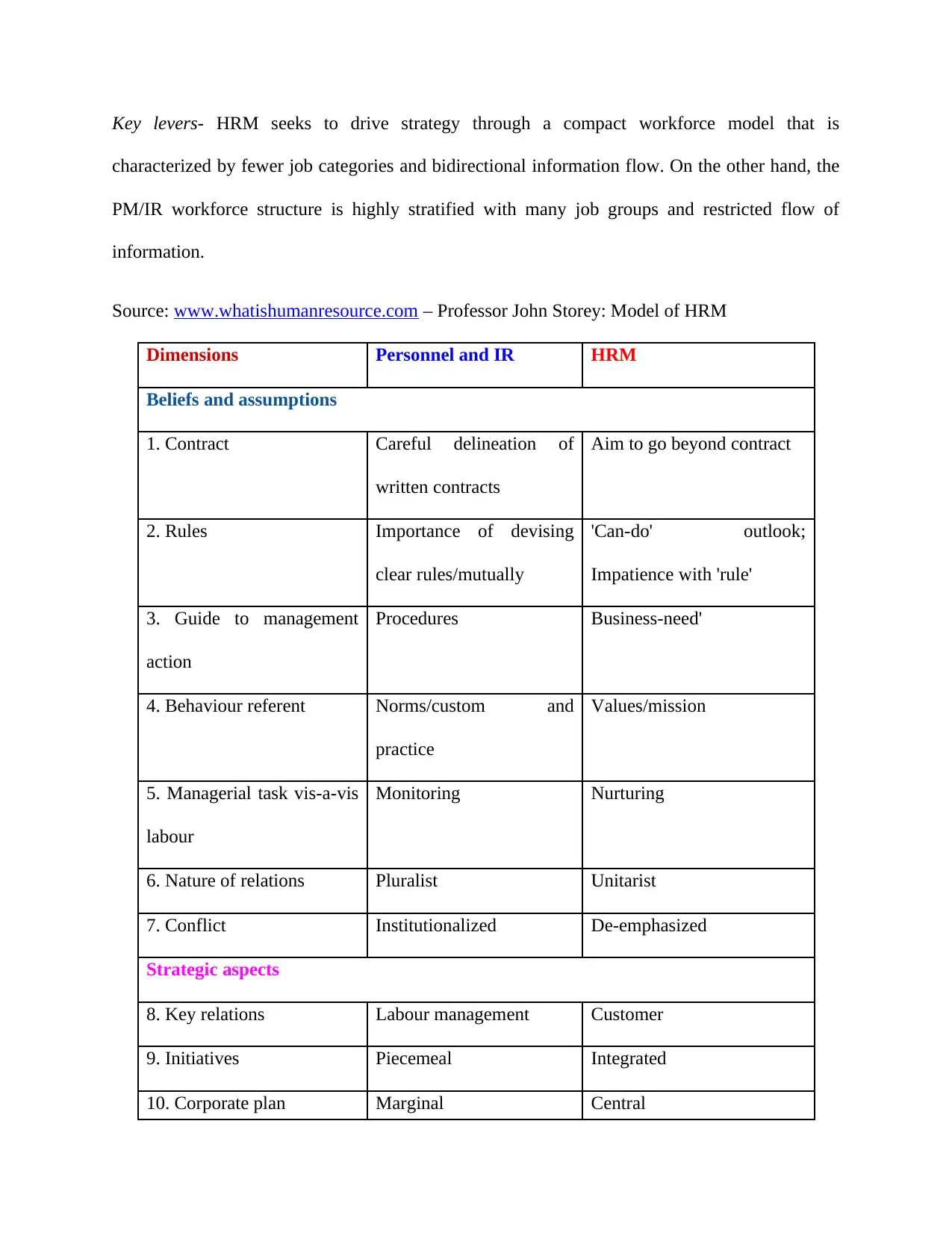
Key levers- HRM seeks to drive strategy through a compact workforce model that is
characterized by fewer job categories and bidirectional information flow. On the other hand, the
PM/IR workforce structure is highly stratified with many job groups and restricted flow of
information.
Source: www.whatishumanresource.com – Professor John Storey: Model of HRM
Dimensions Personnel and IR HRM
Beliefs and assumptions
1. Contract Careful delineation of
written contracts
Aim to go beyond contract
2. Rules Importance of devising
clear rules/mutually
'Can-do' outlook;
Impatience with 'rule'
3. Guide to management
action
Procedures Business-need'
4. Behaviour referent Norms/custom and
practice
Values/mission
5. Managerial task vis-a-vis
labour
Monitoring Nurturing
6. Nature of relations Pluralist Unitarist
7. Conflict Institutionalized De-emphasized
Strategic aspects
8. Key relations Labour management Customer
9. Initiatives Piecemeal Integrated
10. Corporate plan Marginal Central
characterized by fewer job categories and bidirectional information flow. On the other hand, the
PM/IR workforce structure is highly stratified with many job groups and restricted flow of
information.
Source: www.whatishumanresource.com – Professor John Storey: Model of HRM
Dimensions Personnel and IR HRM
Beliefs and assumptions
1. Contract Careful delineation of
written contracts
Aim to go beyond contract
2. Rules Importance of devising
clear rules/mutually
'Can-do' outlook;
Impatience with 'rule'
3. Guide to management
action
Procedures Business-need'
4. Behaviour referent Norms/custom and
practice
Values/mission
5. Managerial task vis-a-vis
labour
Monitoring Nurturing
6. Nature of relations Pluralist Unitarist
7. Conflict Institutionalized De-emphasized
Strategic aspects
8. Key relations Labour management Customer
9. Initiatives Piecemeal Integrated
10. Corporate plan Marginal Central
Paraphrase This Document
Need a fresh take? Get an instant paraphrase of this document with our AI Paraphraser
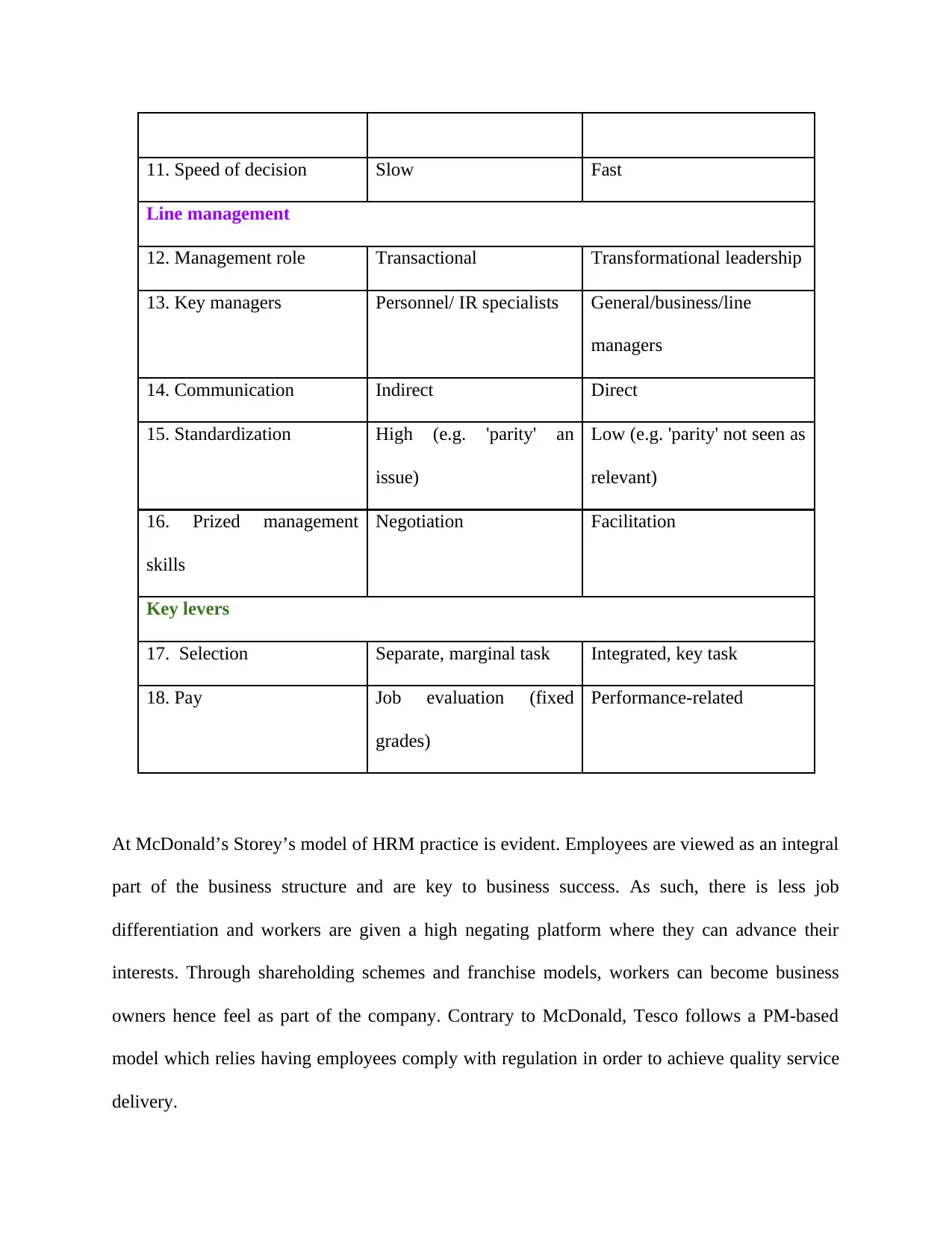
11. Speed of decision Slow Fast
Line management
12. Management role Transactional Transformational leadership
13. Key managers Personnel/ IR specialists General/business/line
managers
14. Communication Indirect Direct
15. Standardization High (e.g. 'parity' an
issue)
Low (e.g. 'parity' not seen as
relevant)
16. Prized management
skills
Negotiation Facilitation
Key levers
17. Selection Separate, marginal task Integrated, key task
18. Pay Job evaluation (fixed
grades)
Performance-related
At McDonald’s Storey’s model of HRM practice is evident. Employees are viewed as an integral
part of the business structure and are key to business success. As such, there is less job
differentiation and workers are given a high negating platform where they can advance their
interests. Through shareholding schemes and franchise models, workers can become business
owners hence feel as part of the company. Contrary to McDonald, Tesco follows a PM-based
model which relies having employees comply with regulation in order to achieve quality service
delivery.
Line management
12. Management role Transactional Transformational leadership
13. Key managers Personnel/ IR specialists General/business/line
managers
14. Communication Indirect Direct
15. Standardization High (e.g. 'parity' an
issue)
Low (e.g. 'parity' not seen as
relevant)
16. Prized management
skills
Negotiation Facilitation
Key levers
17. Selection Separate, marginal task Integrated, key task
18. Pay Job evaluation (fixed
grades)
Performance-related
At McDonald’s Storey’s model of HRM practice is evident. Employees are viewed as an integral
part of the business structure and are key to business success. As such, there is less job
differentiation and workers are given a high negating platform where they can advance their
interests. Through shareholding schemes and franchise models, workers can become business
owners hence feel as part of the company. Contrary to McDonald, Tesco follows a PM-based
model which relies having employees comply with regulation in order to achieve quality service
delivery.
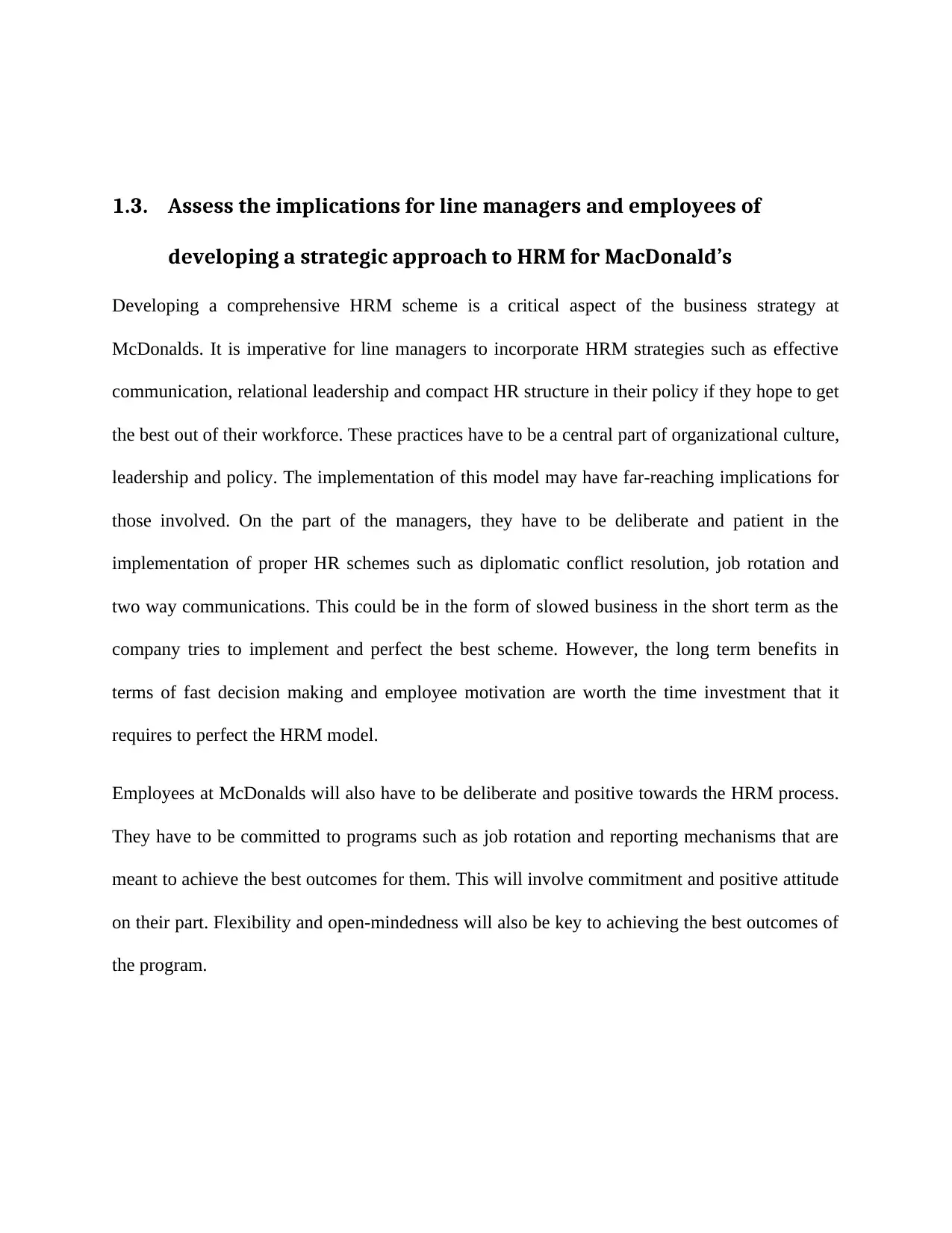
1.3. Assess the implications for line managers and employees of
developing a strategic approach to HRM for MacDonald’s
Developing a comprehensive HRM scheme is a critical aspect of the business strategy at
McDonalds. It is imperative for line managers to incorporate HRM strategies such as effective
communication, relational leadership and compact HR structure in their policy if they hope to get
the best out of their workforce. These practices have to be a central part of organizational culture,
leadership and policy. The implementation of this model may have far-reaching implications for
those involved. On the part of the managers, they have to be deliberate and patient in the
implementation of proper HR schemes such as diplomatic conflict resolution, job rotation and
two way communications. This could be in the form of slowed business in the short term as the
company tries to implement and perfect the best scheme. However, the long term benefits in
terms of fast decision making and employee motivation are worth the time investment that it
requires to perfect the HRM model.
Employees at McDonalds will also have to be deliberate and positive towards the HRM process.
They have to be committed to programs such as job rotation and reporting mechanisms that are
meant to achieve the best outcomes for them. This will involve commitment and positive attitude
on their part. Flexibility and open-mindedness will also be key to achieving the best outcomes of
the program.
developing a strategic approach to HRM for MacDonald’s
Developing a comprehensive HRM scheme is a critical aspect of the business strategy at
McDonalds. It is imperative for line managers to incorporate HRM strategies such as effective
communication, relational leadership and compact HR structure in their policy if they hope to get
the best out of their workforce. These practices have to be a central part of organizational culture,
leadership and policy. The implementation of this model may have far-reaching implications for
those involved. On the part of the managers, they have to be deliberate and patient in the
implementation of proper HR schemes such as diplomatic conflict resolution, job rotation and
two way communications. This could be in the form of slowed business in the short term as the
company tries to implement and perfect the best scheme. However, the long term benefits in
terms of fast decision making and employee motivation are worth the time investment that it
requires to perfect the HRM model.
Employees at McDonalds will also have to be deliberate and positive towards the HRM process.
They have to be committed to programs such as job rotation and reporting mechanisms that are
meant to achieve the best outcomes for them. This will involve commitment and positive attitude
on their part. Flexibility and open-mindedness will also be key to achieving the best outcomes of
the program.
⊘ This is a preview!⊘
Do you want full access?
Subscribe today to unlock all pages.

Trusted by 1+ million students worldwide
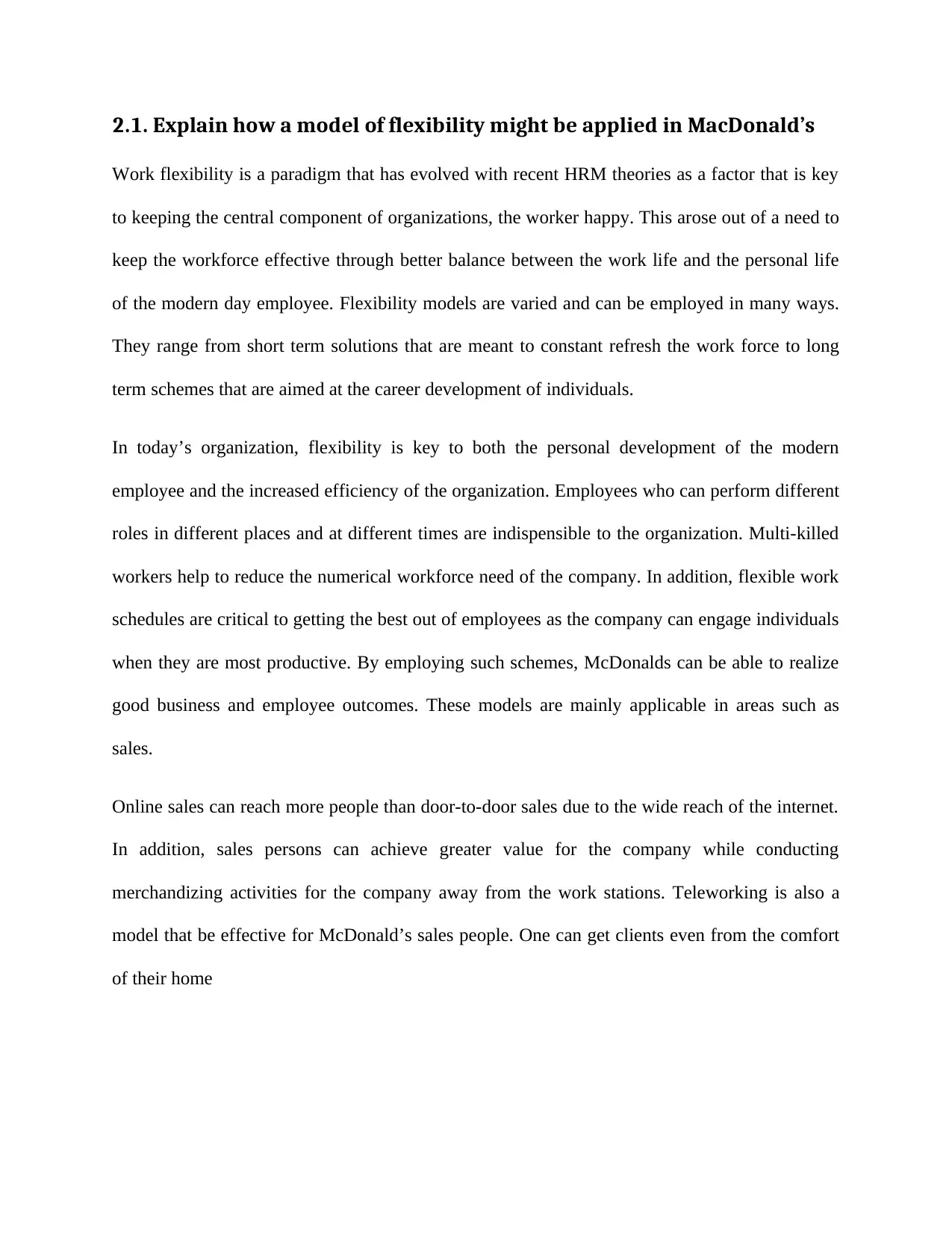
2.1. Explain how a model of flexibility might be applied in MacDonald’s
Work flexibility is a paradigm that has evolved with recent HRM theories as a factor that is key
to keeping the central component of organizations, the worker happy. This arose out of a need to
keep the workforce effective through better balance between the work life and the personal life
of the modern day employee. Flexibility models are varied and can be employed in many ways.
They range from short term solutions that are meant to constant refresh the work force to long
term schemes that are aimed at the career development of individuals.
In today’s organization, flexibility is key to both the personal development of the modern
employee and the increased efficiency of the organization. Employees who can perform different
roles in different places and at different times are indispensible to the organization. Multi-killed
workers help to reduce the numerical workforce need of the company. In addition, flexible work
schedules are critical to getting the best out of employees as the company can engage individuals
when they are most productive. By employing such schemes, McDonalds can be able to realize
good business and employee outcomes. These models are mainly applicable in areas such as
sales.
Online sales can reach more people than door-to-door sales due to the wide reach of the internet.
In addition, sales persons can achieve greater value for the company while conducting
merchandizing activities for the company away from the work stations. Teleworking is also a
model that be effective for McDonald’s sales people. One can get clients even from the comfort
of their home
Work flexibility is a paradigm that has evolved with recent HRM theories as a factor that is key
to keeping the central component of organizations, the worker happy. This arose out of a need to
keep the workforce effective through better balance between the work life and the personal life
of the modern day employee. Flexibility models are varied and can be employed in many ways.
They range from short term solutions that are meant to constant refresh the work force to long
term schemes that are aimed at the career development of individuals.
In today’s organization, flexibility is key to both the personal development of the modern
employee and the increased efficiency of the organization. Employees who can perform different
roles in different places and at different times are indispensible to the organization. Multi-killed
workers help to reduce the numerical workforce need of the company. In addition, flexible work
schedules are critical to getting the best out of employees as the company can engage individuals
when they are most productive. By employing such schemes, McDonalds can be able to realize
good business and employee outcomes. These models are mainly applicable in areas such as
sales.
Online sales can reach more people than door-to-door sales due to the wide reach of the internet.
In addition, sales persons can achieve greater value for the company while conducting
merchandizing activities for the company away from the work stations. Teleworking is also a
model that be effective for McDonald’s sales people. One can get clients even from the comfort
of their home
Paraphrase This Document
Need a fresh take? Get an instant paraphrase of this document with our AI Paraphraser
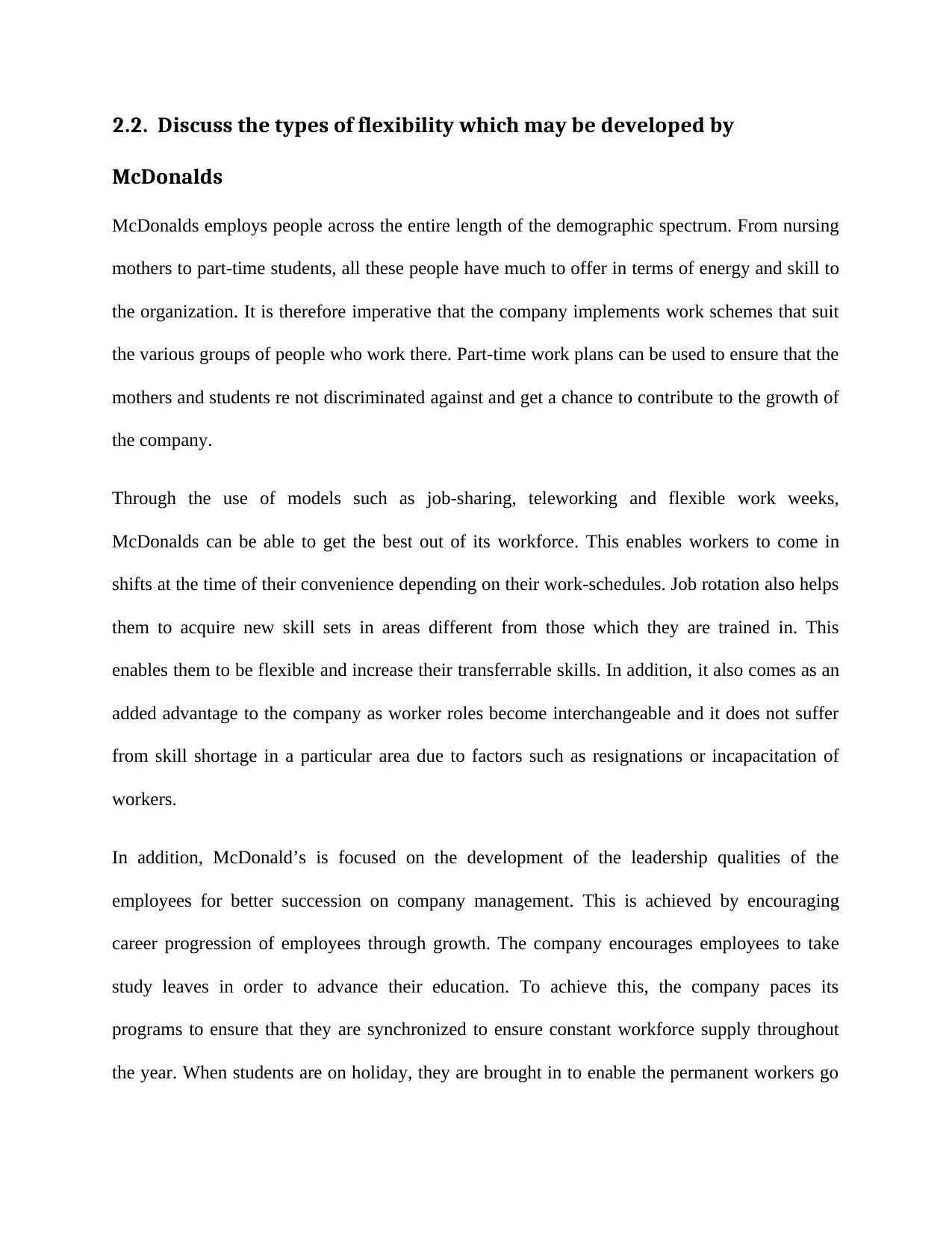
2.2. Discuss the types of flexibility which may be developed by
McDonalds
McDonalds employs people across the entire length of the demographic spectrum. From nursing
mothers to part-time students, all these people have much to offer in terms of energy and skill to
the organization. It is therefore imperative that the company implements work schemes that suit
the various groups of people who work there. Part-time work plans can be used to ensure that the
mothers and students re not discriminated against and get a chance to contribute to the growth of
the company.
Through the use of models such as job-sharing, teleworking and flexible work weeks,
McDonalds can be able to get the best out of its workforce. This enables workers to come in
shifts at the time of their convenience depending on their work-schedules. Job rotation also helps
them to acquire new skill sets in areas different from those which they are trained in. This
enables them to be flexible and increase their transferrable skills. In addition, it also comes as an
added advantage to the company as worker roles become interchangeable and it does not suffer
from skill shortage in a particular area due to factors such as resignations or incapacitation of
workers.
In addition, McDonald’s is focused on the development of the leadership qualities of the
employees for better succession on company management. This is achieved by encouraging
career progression of employees through growth. The company encourages employees to take
study leaves in order to advance their education. To achieve this, the company paces its
programs to ensure that they are synchronized to ensure constant workforce supply throughout
the year. When students are on holiday, they are brought in to enable the permanent workers go
McDonalds
McDonalds employs people across the entire length of the demographic spectrum. From nursing
mothers to part-time students, all these people have much to offer in terms of energy and skill to
the organization. It is therefore imperative that the company implements work schemes that suit
the various groups of people who work there. Part-time work plans can be used to ensure that the
mothers and students re not discriminated against and get a chance to contribute to the growth of
the company.
Through the use of models such as job-sharing, teleworking and flexible work weeks,
McDonalds can be able to get the best out of its workforce. This enables workers to come in
shifts at the time of their convenience depending on their work-schedules. Job rotation also helps
them to acquire new skill sets in areas different from those which they are trained in. This
enables them to be flexible and increase their transferrable skills. In addition, it also comes as an
added advantage to the company as worker roles become interchangeable and it does not suffer
from skill shortage in a particular area due to factors such as resignations or incapacitation of
workers.
In addition, McDonald’s is focused on the development of the leadership qualities of the
employees for better succession on company management. This is achieved by encouraging
career progression of employees through growth. The company encourages employees to take
study leaves in order to advance their education. To achieve this, the company paces its
programs to ensure that they are synchronized to ensure constant workforce supply throughout
the year. When students are on holiday, they are brought in to enable the permanent workers go
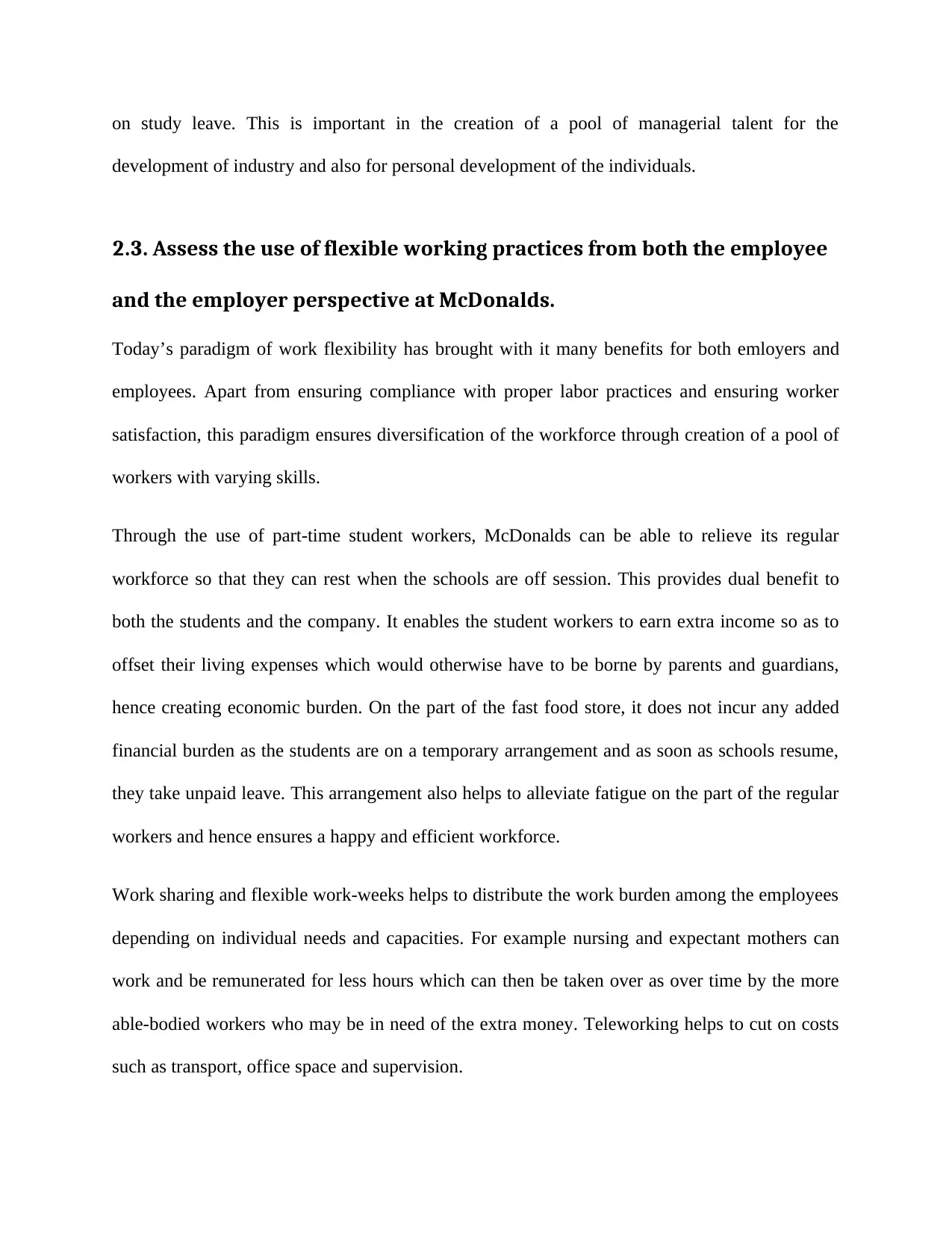
on study leave. This is important in the creation of a pool of managerial talent for the
development of industry and also for personal development of the individuals.
2.3. Assess the use of flexible working practices from both the employee
and the employer perspective at McDonalds.
Today’s paradigm of work flexibility has brought with it many benefits for both emloyers and
employees. Apart from ensuring compliance with proper labor practices and ensuring worker
satisfaction, this paradigm ensures diversification of the workforce through creation of a pool of
workers with varying skills.
Through the use of part-time student workers, McDonalds can be able to relieve its regular
workforce so that they can rest when the schools are off session. This provides dual benefit to
both the students and the company. It enables the student workers to earn extra income so as to
offset their living expenses which would otherwise have to be borne by parents and guardians,
hence creating economic burden. On the part of the fast food store, it does not incur any added
financial burden as the students are on a temporary arrangement and as soon as schools resume,
they take unpaid leave. This arrangement also helps to alleviate fatigue on the part of the regular
workers and hence ensures a happy and efficient workforce.
Work sharing and flexible work-weeks helps to distribute the work burden among the employees
depending on individual needs and capacities. For example nursing and expectant mothers can
work and be remunerated for less hours which can then be taken over as over time by the more
able-bodied workers who may be in need of the extra money. Teleworking helps to cut on costs
such as transport, office space and supervision.
development of industry and also for personal development of the individuals.
2.3. Assess the use of flexible working practices from both the employee
and the employer perspective at McDonalds.
Today’s paradigm of work flexibility has brought with it many benefits for both emloyers and
employees. Apart from ensuring compliance with proper labor practices and ensuring worker
satisfaction, this paradigm ensures diversification of the workforce through creation of a pool of
workers with varying skills.
Through the use of part-time student workers, McDonalds can be able to relieve its regular
workforce so that they can rest when the schools are off session. This provides dual benefit to
both the students and the company. It enables the student workers to earn extra income so as to
offset their living expenses which would otherwise have to be borne by parents and guardians,
hence creating economic burden. On the part of the fast food store, it does not incur any added
financial burden as the students are on a temporary arrangement and as soon as schools resume,
they take unpaid leave. This arrangement also helps to alleviate fatigue on the part of the regular
workers and hence ensures a happy and efficient workforce.
Work sharing and flexible work-weeks helps to distribute the work burden among the employees
depending on individual needs and capacities. For example nursing and expectant mothers can
work and be remunerated for less hours which can then be taken over as over time by the more
able-bodied workers who may be in need of the extra money. Teleworking helps to cut on costs
such as transport, office space and supervision.
⊘ This is a preview!⊘
Do you want full access?
Subscribe today to unlock all pages.

Trusted by 1+ million students worldwide
1 out of 22
Related Documents
Your All-in-One AI-Powered Toolkit for Academic Success.
+13062052269
info@desklib.com
Available 24*7 on WhatsApp / Email
![[object Object]](/_next/static/media/star-bottom.7253800d.svg)
Unlock your academic potential
Copyright © 2020–2025 A2Z Services. All Rights Reserved. Developed and managed by ZUCOL.




